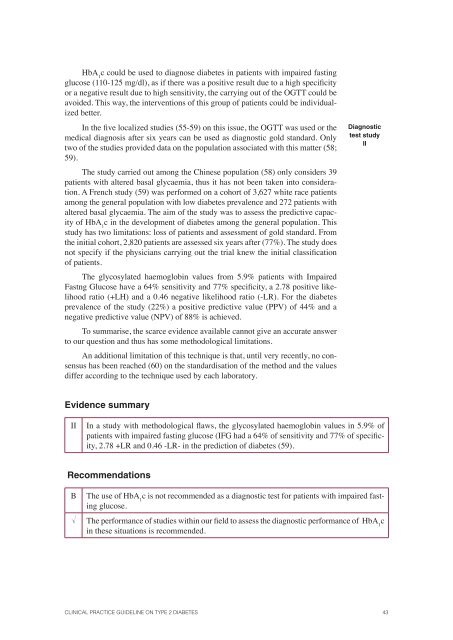2,46 Mb - GuÃaSalud
2,46 Mb - GuÃaSalud
2,46 Mb - GuÃaSalud
You also want an ePaper? Increase the reach of your titles
YUMPU automatically turns print PDFs into web optimized ePapers that Google loves.
HbA 1<br />
c could be used to diagnose diabetes in patients with impaired fasting<br />
glucose (110-125 mg/dl), as if there was a positive result due to a high specificity<br />
or a negative result due to high sensitivity, the carrying out of the OGTT could be<br />
avoided. This way, the interventions of this group of patients could be individualized<br />
better.<br />
In the five localized studies (55-59) on this issue, the OGTT was used or the<br />
medical diagnosis after six years can be used as diagnostic gold standard. Only<br />
two of the studies provided data on the population associated with this matter (58;<br />
59).<br />
The study carried out among the Chinese population (58) only considers 39<br />
patients with altered basal glycaemia, thus it has not been taken into consideration.<br />
A French study (59) was performed on a cohort of 3,627 white race patients<br />
among the general population with low diabetes prevalence and 272 patients with<br />
altered basal glycaemia. The aim of the study was to assess the predictive capacity<br />
of HbA 1<br />
c in the development of diabetes among the general population. This<br />
study has two limitations: loss of patients and assessment of gold standard. From<br />
the initial cohort, 2,820 patients are assessed six years after (77%). The study does<br />
not specify if the physicians carrying out the trial knew the initial classification<br />
of patients.<br />
The glycosylated haemoglobin values from 5.9% patients with Impaired<br />
Fastng Glucose have a 64% sensitivity and 77% specificity, a 2.78 positive likelihood<br />
ratio (+LH) and a 0.<strong>46</strong> negative likelihood ratio (-LR). For the diabetes<br />
prevalence of the study (22%) a positive predictive value (PPV) of 44% and a<br />
negative predictive value (NPV) of 88% is achieved.<br />
To summarise, the scarce evidence available cannot give an accurate answer<br />
to our question and thus has some methodological limitations.<br />
An additional limitation of this technique is that, until very recently, no consensus<br />
has been reached (60) on the standardisation of the method and the values<br />
differ according to the technique used by each laboratory.<br />
Diagnostic<br />
test study<br />
II<br />
Evidence summary<br />
II<br />
In a study with methodological flaws, the glycosylated haemoglobin values in 5.9% of<br />
patients with impaired fasting glucose (IFG had a 64% of sensitivity and 77% of specificity,<br />
2.78 +LR and 0.<strong>46</strong> -LR- in the prediction of diabetes (59).<br />
Recommendations<br />
B<br />
<br />
The use of HbA 1<br />
c is not recommended as a diagnostic test for patients with impaired fasting<br />
glucose.<br />
The performance of studies within our field to assess the diagnostic performance of HbA 1<br />
c<br />
in these situations is recommended.<br />
CLINICAL PRACTICE GUIDELINE ON TYPE 2 DIABETES 43

















